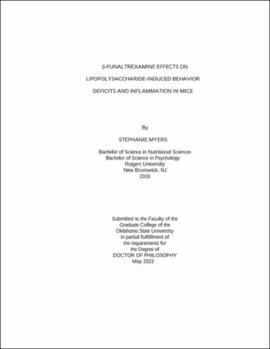| dc.description.abstract | Inflammation plays a pivotal role in neurological and peripheral disorders. Specifically, inflammation is one of the common factors in diseases such as anxiety, depression, Alzheimer’s disease (AD), Parkinson’s disease (PD), inflammatory bowel disease (IBD), and many others that have all been linked to inflammatory changes in our central or peripheral systems. Thus, exploring potential treatments geared toward the abatement of inflammation is crucial to the continuation of treatment development. One pharmacological agent researched for its anti-inflammatory effects is β-funaltrexamine (β-FNA), a selective mu-opioid receptor (MOR) antagonist. Preclinical studies using in vitro human astroglial cells showed that β-FNA inhibited inflammatory signaling, NF-κB signaling, and chemokine expression in a mechanism unrelated to MOR. Also, the neuroprotective effects of β-FNA were discovered in a preclinical model of lipopolysaccharide (LPS)-induced neuroinflammation and sickness-like behavior when administered before LPS. This study determines the effects of β-FNA (50 mg/kg, i.p.) on LPS-induced (0.83 mg/kg i.p.) sickness-like behavior using a 10 min open field test and anxiety-like behavior using a 5 min elevated plus maze in male and female C57BL/6J mice. Depending on the study, it also assesses the effects on LPS-induced neuro and peripheral inflammation when β-FNA is administered immediately, 4 h or 10 h post-LPS. Tissue collected included the whole brain, hippocampus, prefrontal cortex, cerebellum/brain stem, spleen, liver, small intestine, large intestine, and plasma. Levels of inflammatory cytokines/chemokines (TNF-α, IL-6, IL-1β, CXCL10, CCL2) were measured using an enzyme-linked immunosorbent assay (ELISA), and inflammatory factors (NF-κB-p65, TAK1, p38 MAPK, GFAP) were measured using a western blot analysis. Also, to our knowledge, this is the first time the effects of β-FNA on female mice has been assessed. Differential effects of β-FNA were found between the whole brain vs. brain regions, central vs. peripheral nervous system, inflammatory factors, sexes, and temporal differences. Overall, this study will provide insight into the protection offered by β-FNA in both the central and peripheral systems and provides further exploration into additional therapeutic options for neurological disorders. | |
